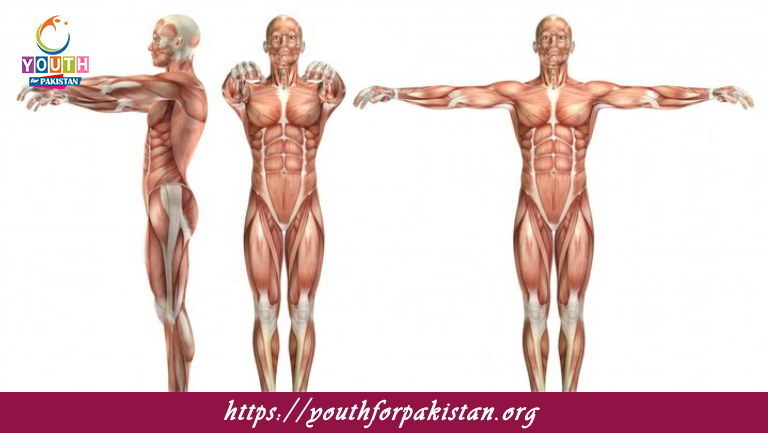Welcome to the Skeletal Muscles MDCAT MCQs with Answers. In this post, we have shared Skeletal Muscles Multiple Choice Questions and Answers for PMC MDCAT 2024. Each question in MDCAT Biology offers a chance to enhance your knowledge regarding Skeletal Muscles MCQs in this MDCAT Online Test.
Skeletal muscles are primarily responsible for: a) Blood circulation
b) Body movement
c) Hormone secretion
d) Nerve conduction
The basic unit of a skeletal muscle is the: a) Myofibril
b) Sarcomere
c) Neuron
d) Mitochondria
Skeletal muscles are controlled by the: a) Endocrine system
b) Autonomic nervous system
c) Somatic nervous system
d) Digestive system
The connective tissue covering that surrounds an entire skeletal muscle is called: a) Endomysium
b) Perimysium
c) Epimysium
d) Sarcomere
The functional unit of contraction in skeletal muscles is: a) Myosin
b) Sarcomere
c) Fascicle
d) Perimysium
Which of the following proteins are involved in skeletal muscle contraction? a) Actin and myosin
b) Collagen and elastin
c) Hemoglobin and keratin
d) Tropomyosin and fibrinogen
Skeletal muscle fibers are: a) Branched
b) Striated
c) Smooth
d) Non-striated
The thick filament in skeletal muscles is: a) Actin
b) Tropomyosin
c) Myosin
d) Troponin
Skeletal muscles contract in response to: a) Hormones
b) Neural impulses
c) Blood flow
d) Chemical stimuli
The neurotransmitter involved in skeletal muscle contraction is: a) Dopamine
b) Serotonin
c) Acetylcholine
d) Norepinephrine
Which type of muscle exhibits voluntary control? a) Cardiac muscle
b) Smooth muscle
c) Skeletal muscle
d) All of the above
The attachment of a skeletal muscle to a stationary bone is called: a) Insertion
b) Origin
c) Tendon
d) Ligament
Which ion is essential for skeletal muscle contraction? a) Sodium
b) Potassium
c) Calcium
d) Magnesium
The sliding filament theory explains: a) Muscle relaxation
b) Muscle contraction
c) Muscle fatigue
d) Muscle development
Skeletal muscles are attached to bones via: a) Ligaments
b) Cartilage
c) Tendons
d) Periosteum
The energy source used for skeletal muscle contraction is: a) Glucose
b) ATP
c) Fatty acids
d) Glycogen
The sarcoplasmic reticulum in skeletal muscle stores: a) Sodium
b) Potassium
c) Calcium
d) ATP
The dark band in a skeletal muscle fiber is due to: a) Actin filaments
b) Myosin filaments
c) Tropomyosin
d) Z-line
Skeletal muscle fibers are: a) Uninucleated
b) Multinucleated
c) Binucleated
d) None of the above
The Z-line in a skeletal muscle sarcomere marks: a) The start of a myofibril
b) The boundary of a sarcomere
c) The location of the motor neuron
d) The attachment of thick filaments
Muscle fatigue occurs when: a) Calcium levels increase
b) ATP is depleted
c) Nerve impulses increase
d) Glycogen is stored
The protein that blocks myosin-binding sites on actin during muscle relaxation is: a) Troponin
b) Tropomyosin
c) Myoglobin
d) Actinin
The point where a motor neuron stimulates a skeletal muscle fiber is called: a) Motor end plate
b) Sarcolemma
c) Neuromuscular junction
d) Synaptic cleft
The primary function of skeletal muscles is: a) Production of heat
b) Movement of the skeleton
c) Protection of internal organs
d) All of the above
Skeletal muscle contraction begins when: a) Myosin binds to actin
b) Calcium ions are released from the sarcoplasmic reticulum
c) Acetylcholine binds to receptors on the sarcolemma
d) ATP is synthesized
Skeletal muscle cells are also known as: a) Myofibrils
b) Myoblasts
c) Muscle fibers
d) Fascicles
The smallest contractile unit of a skeletal muscle is: a) Myofibril
b) Sarcomere
c) Fascicle
d) Muscle fiber
The protein that binds calcium in skeletal muscle contraction is: a) Troponin
b) Tropomyosin
c) Actin
d) Myosin
Skeletal muscle contraction is regulated by: a) Endocrine system
b) Nervous system
c) Circulatory system
d) Digestive system
The release of calcium from the sarcoplasmic reticulum triggers: a) Muscle contraction
b) Muscle relaxation
c) Nerve impulse
d) Muscle atrophy
During skeletal muscle contraction, the I-band: a) Increases in length
b) Decreases in length
c) Remains the same
d) Disappears completely
Skeletal muscle fibers are categorized as: a) Uninucleated
b) Multinucleated
c) Binucleated
d) None of the above
The role of ATP in muscle contraction is to: a) Break down actin
b) Provide energy for the power stroke
c) Attach myosin to actin
d) Store calcium
The thick filament of the skeletal muscle sarcomere is made of: a) Actin
b) Myosin
c) Tropomyosin
d) Troponin
During muscle contraction, the length of which region remains unchanged? a) A-band
b) I-band
c) H-zone
d) Z-line
The enzyme that breaks down acetylcholine at the neuromuscular junction is: a) Acetylcholinesterase
b) Myosin kinase
c) Troponinase
d) Actinase
Skeletal muscles maintain posture through: a) Voluntary contraction
b) Muscle tone
c) Muscle fatigue
d) Involuntary contraction
Muscle soreness after intense exercise is due to: a) Calcium buildup
b) Lactic acid accumulation
c) ATP depletion
d) Protein breakdown
The T-tubules in skeletal muscle fibers are involved in: a) Storing calcium
b) Propagating action potentials
c) Synthesizing ATP
d) Muscle relaxation
If you are interested to enhance your knowledge regarding Physics, Chemistry, Computer, and Biology please click on the link of each category, you will be redirected to dedicated website for each category.








